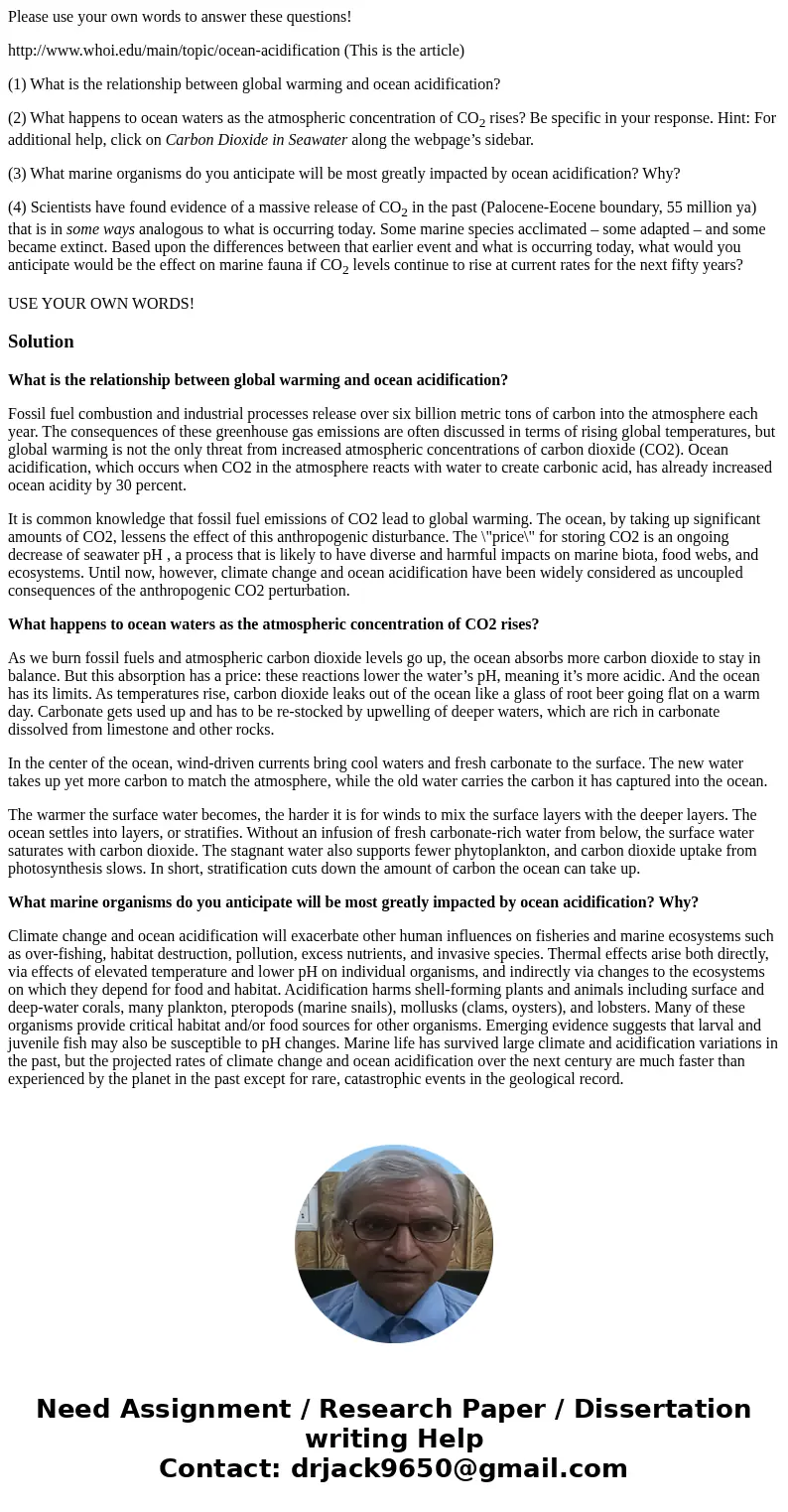Please use your own words to answer these questions httpwwww
Please use your own words to answer these questions!
http://www.whoi.edu/main/topic/ocean-acidification (This is the article)
(1) What is the relationship between global warming and ocean acidification?
(2) What happens to ocean waters as the atmospheric concentration of CO2 rises? Be specific in your response. Hint: For additional help, click on Carbon Dioxide in Seawater along the webpage’s sidebar.
(3) What marine organisms do you anticipate will be most greatly impacted by ocean acidification? Why?
(4) Scientists have found evidence of a massive release of CO2 in the past (Palocene-Eocene boundary, 55 million ya) that is in some ways analogous to what is occurring today. Some marine species acclimated – some adapted – and some became extinct. Based upon the differences between that earlier event and what is occurring today, what would you anticipate would be the effect on marine fauna if CO2 levels continue to rise at current rates for the next fifty years?
USE YOUR OWN WORDS!
Solution
What is the relationship between global warming and ocean acidification?
Fossil fuel combustion and industrial processes release over six billion metric tons of carbon into the atmosphere each year. The consequences of these greenhouse gas emissions are often discussed in terms of rising global temperatures, but global warming is not the only threat from increased atmospheric concentrations of carbon dioxide (CO2). Ocean acidification, which occurs when CO2 in the atmosphere reacts with water to create carbonic acid, has already increased ocean acidity by 30 percent.
It is common knowledge that fossil fuel emissions of CO2 lead to global warming. The ocean, by taking up significant amounts of CO2, lessens the effect of this anthropogenic disturbance. The \"price\" for storing CO2 is an ongoing decrease of seawater pH , a process that is likely to have diverse and harmful impacts on marine biota, food webs, and ecosystems. Until now, however, climate change and ocean acidification have been widely considered as uncoupled consequences of the anthropogenic CO2 perturbation.
What happens to ocean waters as the atmospheric concentration of CO2 rises?
As we burn fossil fuels and atmospheric carbon dioxide levels go up, the ocean absorbs more carbon dioxide to stay in balance. But this absorption has a price: these reactions lower the water’s pH, meaning it’s more acidic. And the ocean has its limits. As temperatures rise, carbon dioxide leaks out of the ocean like a glass of root beer going flat on a warm day. Carbonate gets used up and has to be re-stocked by upwelling of deeper waters, which are rich in carbonate dissolved from limestone and other rocks.
In the center of the ocean, wind-driven currents bring cool waters and fresh carbonate to the surface. The new water takes up yet more carbon to match the atmosphere, while the old water carries the carbon it has captured into the ocean.
The warmer the surface water becomes, the harder it is for winds to mix the surface layers with the deeper layers. The ocean settles into layers, or stratifies. Without an infusion of fresh carbonate-rich water from below, the surface water saturates with carbon dioxide. The stagnant water also supports fewer phytoplankton, and carbon dioxide uptake from photosynthesis slows. In short, stratification cuts down the amount of carbon the ocean can take up.
What marine organisms do you anticipate will be most greatly impacted by ocean acidification? Why?
Climate change and ocean acidification will exacerbate other human influences on fisheries and marine ecosystems such as over-fishing, habitat destruction, pollution, excess nutrients, and invasive species. Thermal effects arise both directly, via effects of elevated temperature and lower pH on individual organisms, and indirectly via changes to the ecosystems on which they depend for food and habitat. Acidification harms shell-forming plants and animals including surface and deep-water corals, many plankton, pteropods (marine snails), mollusks (clams, oysters), and lobsters. Many of these organisms provide critical habitat and/or food sources for other organisms. Emerging evidence suggests that larval and juvenile fish may also be susceptible to pH changes. Marine life has survived large climate and acidification variations in the past, but the projected rates of climate change and ocean acidification over the next century are much faster than experienced by the planet in the past except for rare, catastrophic events in the geological record.

 Homework Sourse
Homework Sourse